Santa Cruz NOMAD X01
- Price: $11,199
- Stroke: 170mm rear, 170mm front
- Wheels: 29″ / 27.5″ carbon
- Drivetrain: 1×12 electronic
What do we like about it: You’ll have a high-end 1×12 electronic drivetrain package in a CC carbon frame, with more expensive hydraulic disc brakes and powerful 29” tires to lead you to the front of the endurance race.
What don’t we like about it: Pricey and high-end racing bikes that are not easy to maintain.
Rating (4.8/5)
Introduction
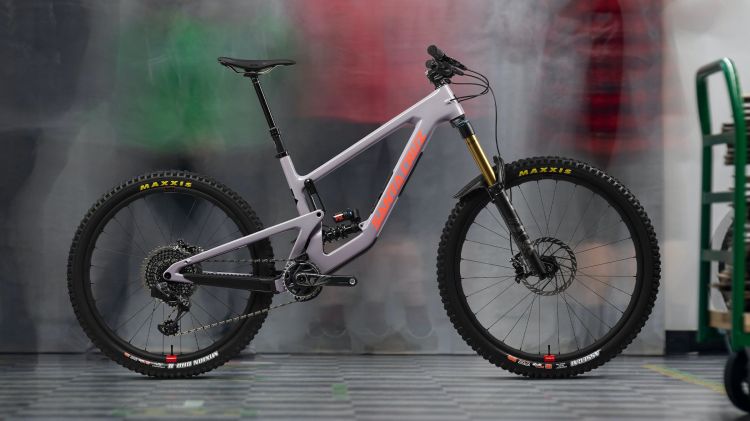
As a pioneering brand, Santa Cruz paved the way for many other upcoming brands on the market. So Santa Cruz NOMAD as a high-end full-suspension bike, the NOMAD X01 AXS carbon frame comes with high-spec components: a 70mm diameter, 38mm fork and 170mm VPP™ rear suspension.
They are coil and air shock compatible for more efficient pedaling. The Maxxis Assegai 29 “x2.5” vacuum tires are capable of aggressively launching long rides with both crush and comfort.
The SRAM 1×12 electronic drivetrain delivers enough power even on demanding upward climbs. In addition, SRAM braking gives you plenty of confidence when rappelling over more drop-off terrain. Meanwhile, it can take you for a fun ride and give you support in races.
The next, if you want to know more about the riding experience, please stay tuned and subscribe, I will bring more reviews.
Learn More: Santa Cruz MEGATOWER XX1 AXS – Why Is Your Mountain Bike More Expensive Than Mine?
Descending
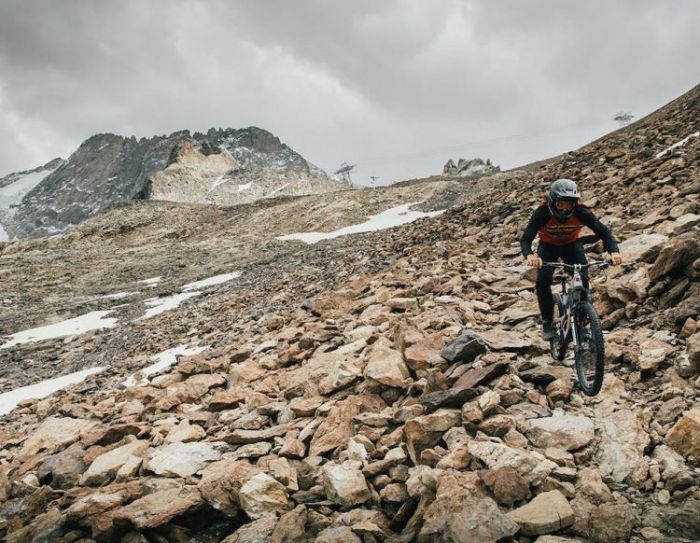
In my mind, the Santa Cruz NOMAD has longer 170mm of travel and a more mixed 29 “x2.5” Maxxis Assegai wheel. So the SRAM 1×12 drivetrain gives me a hell of an aggressive feel.
Whether climbing or descending, it always handles well enough. For me, I’d prefer to call it a “speed champion”. So much so that in my reviews over the past two years, only the Trek slash 9.9 has been able to compete with it. But in terms of a enduro experience, I think the Santa Cruz NOMAD is still slightly better.
The steep 77.9° seat tube angle was like a blade, and I could feel its aggressiveness as I rode the ground in this race. Even if you’re used to riding a road bike, you can still start more easily.
And the first things I did was to put it in the harsh environment of the speedway. Because of this wild forest road has countless rocks and soft, slippery mud, and sharp turns can cause rollover hazards if you’re not careful. Even though I’ve reviewed more bikes, I didn’t dare underestimate the terrain.
Downhill
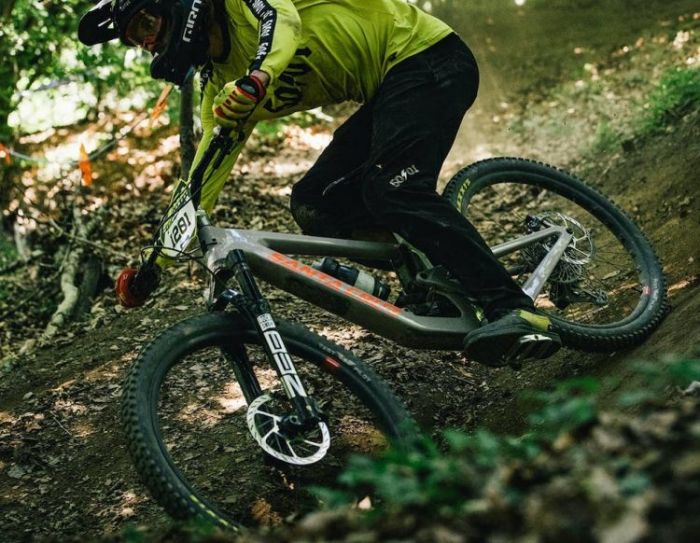
As I strained my muscles for the first descent, Santa Cruz NOMAD took me sharply onto a track that was relatively new to me. I couldn’t help but feel respect for the 133mm of trail, as it allowed me to steer well even at such a fast pace.
As I almost floated over the winding roots of the ground, I knew it was the longer FOX 38 Float Factory fork (170mm) and 29 “x2.5” Maxxis Assegai wheels that was giving me the support I needed. Accordingly, it allows me to powerfully grind over obstacles on the ground.
I soon found that the joy of relief didn’t linger long, and I was greeted by a huge mound of moss-covered rocks. Therefore, I tried to adjust myself to a low position to reduce the squeeze for the rapid descent. As I lifted off, I could clearly hear the sound of airflow across the carbon fiber frame.
In addition, I felt the body suffer a lot of force from the ground after the drop in height. But due to the longer, lower and slacker geometry, I also did not suffer from body folding.
I have to admit that I had moments of trepidation on the wet, muddy downhill that followed. But it was because of the SRAM Code RSC piston hydraulic discs that I was more daring to pull off some tricks. For example, drifting with my body tilted close to the ground. It was a heart-pounding ride.
Climbing
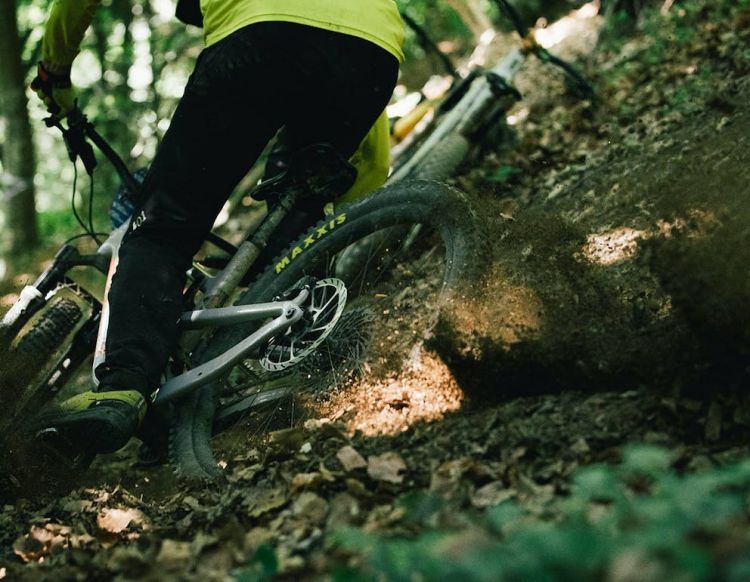
Each retreat of passion is greeted with a more focused ascent. However, for enduro, the rise means ushering in longer and bumpier power output. And the longer travel (170mm) with the more mixed Maxxis Assegai wheels (29 “x2.5”)reduces the bumps.
I also have to admit that its VPP™ suspension could be optimized to strike a balance between pedaling efficiency and full-on impact. But because it has pedal efficiency, climbing the best and highest trails is not a chore like some other bikes.
As I pulled into a gentle, slow ascent of a winding wooded trail halfway up a mountain, I pushed the SRAM cassette into high gear. All the while adjusting the SRAM XG1295 Eagle 1×12 drivetrain to the right gears to match the most physical advantage.
Of course, I think the Maxxis Assegai wheels(27.5/29 “x2.5” ) also provided a big boost. Compared to some hardtail models, I prefer the full shock. Because it can mobilize the whole body’s positive energy to accelerate the operation.
Experience
If you think I’m a rider who is content to simply spin on climbs, you’d be wrong. While climbing is a bit boring for many riders, I can always find a trick. So I purposely pick rock climbs that I can sprint through and generate enough inertia to leap.
This requires me to fully engage SRAM X1 Eagle Carbon DUB 32T crank technology with the SRAM XG1295 Eagle drivetrain. However, I don’t need to worry too much. Because a 1×12 drivetrain with a 29-inch hybrid wheel configuration up front for traction and stability, and a 27.5-inch rear wheel that allows for fast rear wheel steering and lift.
I think the bike itself performs to the best of its ability, whether you’re climbing more difficult terrain or doing professional rappelling. So it’s no exaggeration to say that you just need to match it in your riding.
Main Features
Frame
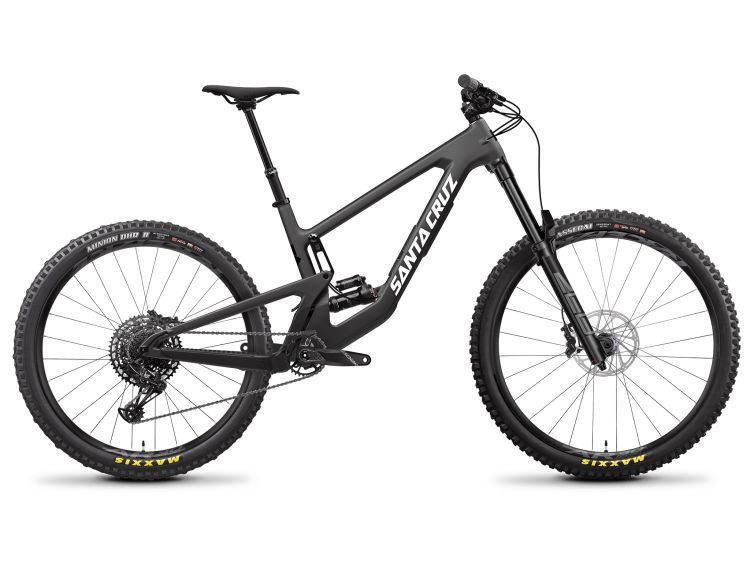
It’s not just the high-end CC carbon frame that surprised me. You might notice its short, stout reverse rotating linkage connecting the front and rear triangles, also forming an extremely strong chassis that reduced lateral flex as I rode.
In terms of detailing, Santa Cruz NOMAD uses an internal alignment design, with both shifting and brakes entering and exiting the brake and shifting positions hidden alignment ports through the down tube. Even when I’m speed riding, I can effectively avoid being dragged by the hoses that affect my play when I’m playing tricks.
And I also noticed that frame stiffness can be adjusted with size. Because a bigger rider means a bigger frame under more stress, and Santa Cruz NOMAD can tailor the stiffness for each size to make sure everyone gets the same ride quality. Accordingly, neat fenders protect the rear shock, neat cable routing in the frame and rear swingarm, and rubber DT protectors to get rid of impacts.
Besides, the Santa Cruz NOMAD down tube is equipped with a high-quality built-in storage box, you can configure the tool kit to keep the tools at hand.
Geometry
The geometry of the Santa Cruz NOMAD X01 is slack and aggressive. Not only will you have a 63.5° head tube angle, but when you’re in full descending bike territory, the steep 77.9° seat tube angle will give us an upright riding position and will be more comfortable for climbing.
It has proportional rear dropouts and gets longer as the frame grows in size. This coupled with a long and confident front center rear center provides a stable riding feel and even power distribution.
With a moderate 346mm of BB height, we didn’t have to worry too much about riding in bumpy rock gardens and could be faster. And its 133mm of trail length gave me stable support even when I was steering at speed. So in an environment where we can’t react instantly, stability is the best measure of a longer ride.
Components and Specifications
Santa Cruz NOMAD Tires
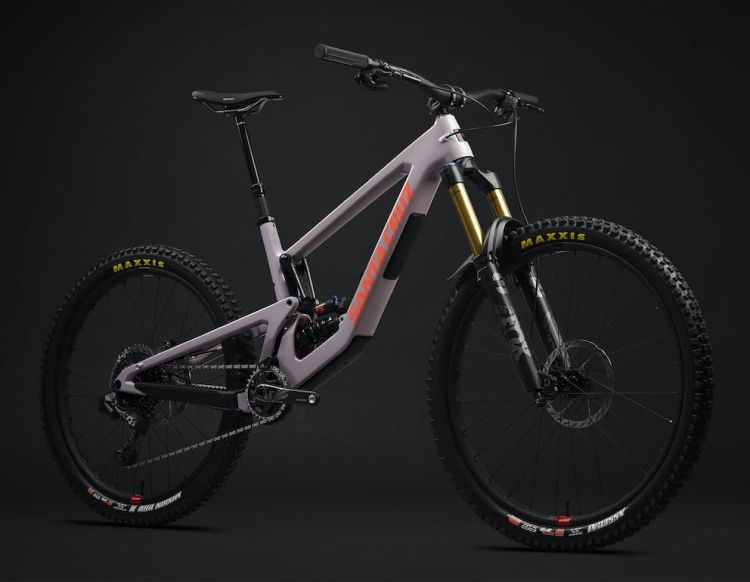
I have a very positive opinion of Santa Cruz NOMAD, especially its wheels, and it all deserves the best of both worlds.
The 29-inch hybrid wheel configuration up front provided plenty of traction and stability. Even when I encountered upward climbing terrain while traversing forest roads, its SRAM drivetrain gave plenty of support and the 29-inch Maxxis wheels improved my pedaling efficiency immensely.
And the 27.5-inch rear wheel allows for fast rear wheel steering and lift. As I described earlier, I’m not a quiet rider and I prefer to navigate unfamiliar terrain. So quick and nimble steering is something I need.
I think Santa Cruz NOMAD is fully aware of the advantages and disadvantages of both sizes of wheels and follows through strictly. It was great to try.
Santa Cruz NOMAD Suspensionvg
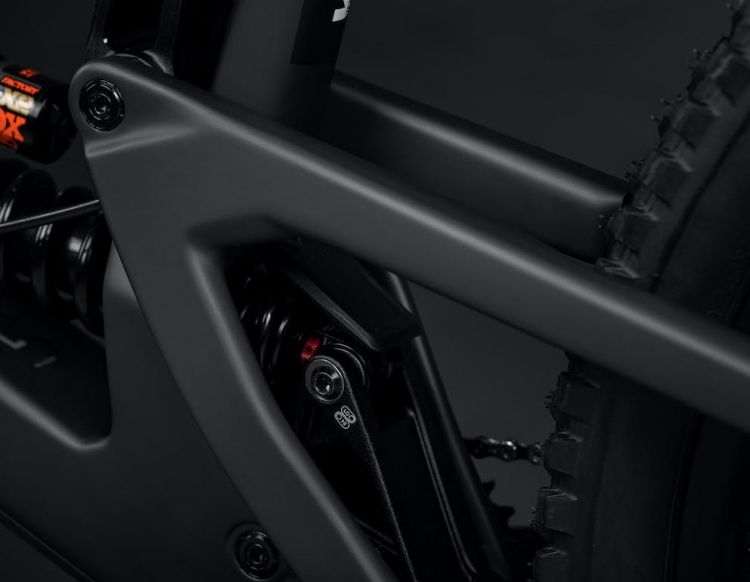
I believe that for the majority of riders if your bike is deplorable in terms of damping, whether it’s the wear and tear on your muscles on bumpy roads that prevent you from riding with endurance, or the severity of damage to components such as tires, it can’t be ignored. However, the RockShox Zeb R fork is made of carbon, which effectively mitigates road ramming and bouncing forces.
In addition, the VPP™ suspension has up to 170 mm of shock travel, which is a very adequate number! Additionally, the smoother lubrication is best reflected in the response of the ride. And it can be continuously optimized to strike a balance between pedaling efficiency and all-out impact.
The Santa Cruz NOMAD excels at absorbing maximum impact, so its riders can charge more confidently through the toughest terrain.
So the whole bike can still show higher strength and more stable performance on steeper and deeper trails. As it says: “All the travel anyone needs in a single-crown bike.”
SRAM NX Eagle 1×12 Drivetrain
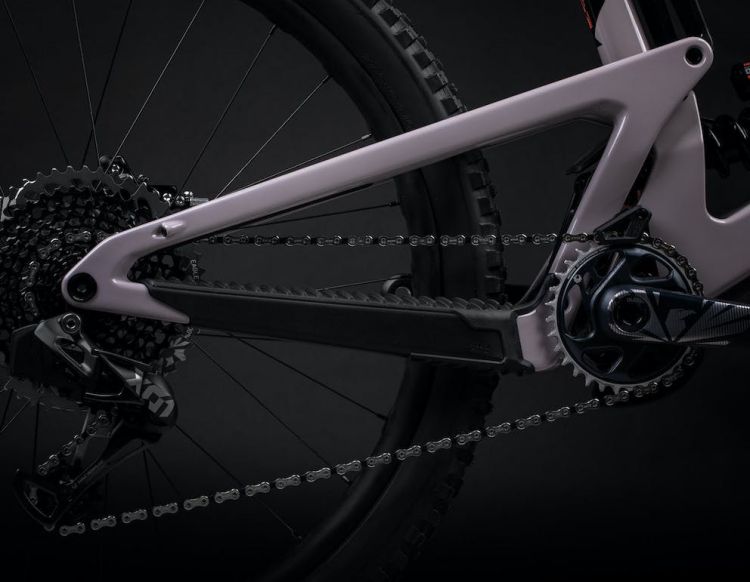
The Santa Cruz NOMAD uses the SRAM NX Eagle 1×12 electronic drivetrain that will get your heart pumping for a second recovery even in the face of the current downturn. Certainly, the SRAM NX Eagle is an SRAM workhorse that rivals the best in the industry. On account of it offers powerful drivetrain performance in a version optimized that will immediately take your riding to a whole new level.
There are a lot of flashy competitors in the industry, such as 2x or 3x drivetrain with more abundant speed regulation options. In my opinion, for today’s riding, it doesn’t provide an extra boost.
If your main endorsement is quality and simplicity, then the 1×12 SRAM NX Eagle electronic drivetrain has done a good job of serving you. At the same time, in the process of speed regulation, Santa Cruz NOMAD has found its lightweight way to shift gears. Additionally, a more ergonomic compact lever shape, crisp, responsive shifting that can be perceived at the rider’s fingertips.
Other Versions Of Santa Cruz NOMAD
Santa Cruz NOMAD S
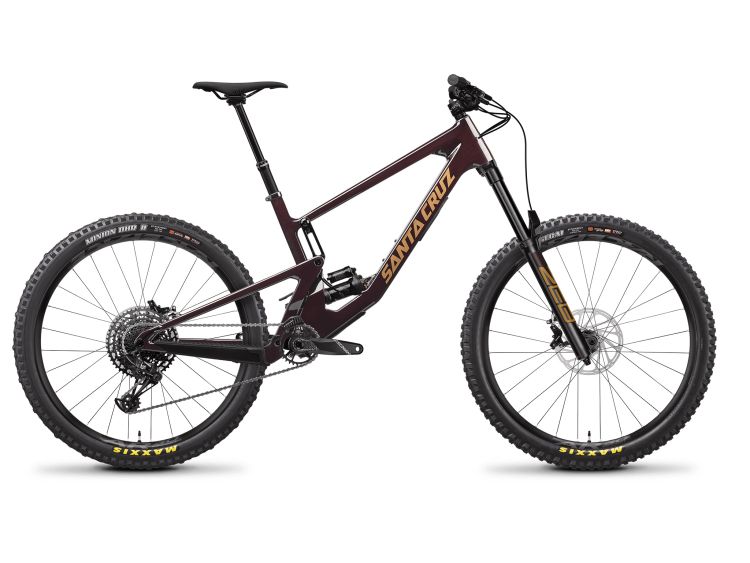
Compared to the $11,199 price tag, the Santa Cruz NOMAD S brings the performance of its components up to par in the $6699 price frame. But in terms of versatility, I prefer the Santa Cruz NOMAD X01 for the following reasons.
First of all, despite the use of a carbon frame on the external frame, Santa Cruz NOMAD X01 chose more high-end CC carbon fiber. It is more malleable, stronger and lighter, and a better investment.
And for one of the key components, such as power tradition, Santa Cruz NOMAD S chose a traditional mechanical 1×12 drivetrain, while Santa Cruz NOMAD X01 chose a more technological electronic drivetrain. Looking at the official stats, you save 25% of the response time for speed control. So I don’t think this is something you’d give up easily if this were a competitive race.
In addition, although both opt for SRAM hydraulic disc brakes, the RSC version of the Santa Cruz NOMAD X01 is more forward in braking.
What do we like about it?
- The star choice, with ultra-high-end component specifications, has reached its peak.
- High-end CC full carbon frame, riding lighter, faster and more energy-efficient.
- Fast-rolling hybrid wheels, not defeated in the face of the burst.
- SRAM 1×12-speed electronic drive system, easy to operate, climbing energy-saving.
- SRAM, hydraulic disc braking more sensitive, to challenge the higher difficulty to bring absolute confidence.
- Longer FOX 38 170mm suspension allows you to ride farther in the face of more complex overlapping terrain.
- More storage space to reduce the burden of riding.
- The simplicity of the internal alignment, while saving a lot of winding for the ride.
What don’t we like about it?
- Can’t compromise on price in the face of high-end components.
FAQs
What is the tire size of the Santa Cruz NOMAD X01?
The tire size of the Santa Cruz NOMAD X01 is 29×2.50”.
What is the drivetrain of the Santa Cruz NOMAD X01?
The drivetrain of the Santa Cruz NOMAD X01 is SRAM XG1295 Eagle 1×12 drivetrain.
What are the brakes of the Santa Cruz NOMAD X01?
The brakes of the Santa Cruz NOMAD X01 are SRAM Code RSC hydraulic discs.
Santa Cruz NOMAD Size Chart
| SIZE | RIDER HEIGHT |
| S | 155 – 165 CM 5’1’’-5’5’’ |
| M | 165 – 175 CM 5’5’’-5’9’’ |
| L | 175- 185 CM 5’9’’-6’1’’ |
| XL | 185- 193 CM 6’1’’-6’4’’ |
| XXL | 193 – 201 CM 6’4’’-6’7’’ |
Video
Santa Cruz NOMAD Series Spec
| Kit | R | S |
| Price | $5499USD | $6699USD |
| Weight | 15.21kg / 33.54lbs | 15.04kg / 33.16lbs |
| Material | Carbon C | Carbon C |
| Fork | RockShox Zeb, 170mm, 27.5″ | FOX 38 Float Performance, 170mm, 27.5″ |
| Shock | RockShox Super Deluxe Select | RockShox Super Deluxe Select+ |
| Rear Derailleur | SRAM NX Eagle, 12spd | SRAM GX Eagle |
| Shifters | SRAM NX Eagle | SRAM GX Eagle |
| Crankset | SRAM Descendant Eagle DUB 32t | SRAM GX Eagle 148 DUB, 32t |
| Cassette | SRAM PG1230 11-50t | SRAM XG1275 Eagle 10-50T |
| Chain | SRAM NX Eagle | SRAM GX Eagle 12 SPD |
| Bottom Bracket | SRAM DUB 68/73mm Threaded BB | SRAM DUB 68/73mm Threaded BB |
| Brakes | SRAM Guide RE | SRAM Code R |
| Brake Rotors | Avid Centerline 200mm | Avid Centerline 200mm |
| Headset | Cane Creek 10 IS Integrated Headset | Cane Creek 40 IS Integrated Headset |
| Bars | E13 TRS Base | Burgtec Alloy Bar, 800mm, 30mm Rise |
| Stem | E13 Base | Burgtec Enduro MK3, 42.5mm |
| Grips | Santa Cruz House Grips or Burgtec Bartender Pro Grip Minnaar | |
| Front Hub | SRAM MTH 716, 15×110, Torque Cap, 32h | DT Swiss 370, 15×110, 6 bolt, 28h |
| Rear Hub | SRAM MTH 746, 12×148, 32h | DT Swiss 370, 12×148, XD, 28h |
| Rims | RaceFace AR Offset 30 27.5″ Rims | RaceFace AR Offset 30 27.5″ |
| Chainguide | E13 TRS Race SL ISCG05 | OneUp Bash |
| Spokes | Sapim Race | Sapim Race |
| Front Tire | Maxxis Assegai 27.5″x2.5″, 3C, Maxx-GRIP, EXO+, TR | Maxxis Assegai 27.5″x2.5″, 3C, MaxxGRIP, EXO+, TR |
| Rear Tire | Maxxis Minion DHR II 27.5″x2.4″, 3C, EXO+ | Maxxis Minion DHR II 27.5″x2.4″, 3C, EXO+ |
| Tubes | Stans Sealant 2oz | Stans Sealant 2oz |
| Seat Post | SDG Tellis | RockShox Reverb Stealth, 31.6 or Race Face Aeffect |
| Saddle | WTB Silverado Race Saddle or WTB Volt | WTB Silverado Pro Saddle or WTB Volt |
Comparison Table
| BIKE | PRICE | DRIVETRAIN | TIRES | BRAKES | Click view |
| Santa Cruz MEGATOWER GX AXS RSV | $9799 | 1×12 electronic | 29 “x2.4″/x2.5” | SRAM Code RSHydraulic Disc | Click View |
| Specialized Stumpjumper EVO Pro | $8600 | 1×12 electronic | 29×2.3″ | SRAM Code RSCHydraulic Disc | Click View |
| Pivot Switchblade Team XTR | $9899 | 1×12 | 29″ x 2.5″ | Shimano XTR M9120Hydraulic Disc | Click View |
| Yeti SB150 T3 | $10600 | 2×11 | 700x35c | Shimano 105 hydraulic disc | Click View |
Santa Cruz MEGATOWER GX AXS RSV vs Santa Cruz NOMAD X01
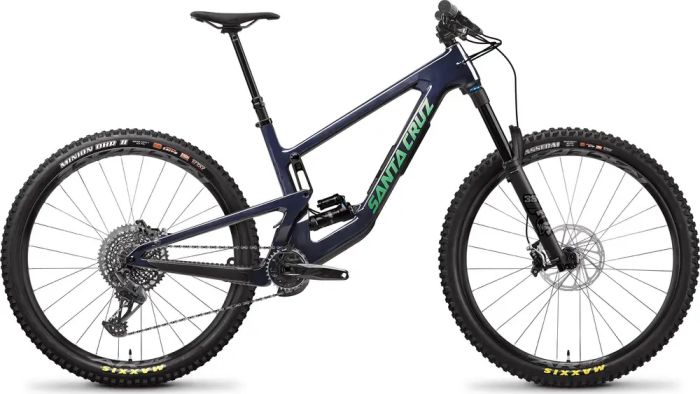
I have to say that I had a hard time deciding between the Santa Cruz MEGATOWER and the Santa Cruz NOMAD.
They both have what I consider to be essentially the same level of components: a mix of 29 “x2.4″/2.5” tires (more aggressive handling performance against harsher and more variable terrain), and an SRAM 1×12 electronic drivetrain (faster and smoother, better for novices). Obviously, the expensive SRAM Code RS hydraulic disc has done its best in swift braking.
But if you compare the two carefully, in terms of the production process, you will find that the more expensive Santa Cruz NOMAD X01 AXS has opted for the more technically advanced CC carbon in terms of the level of craftsmanship, while MEGATOWER is the slightly inferior CC carbon.
Although both are equally good. In terms of travel design, Santa Cruz NOMAD has opted for a consistent 170 mm of travel front-to-back instead of 165 mm rear and 170 mm front. So if I were to choose the best of the best from a more aggressive handling of bumpy terrain or investment perspective, I would favor the NOMAD.
learn more:Santa Cruz MEGATOWER XX1 AXS Review – Why Is Your Mountain Bike More Expensive Than Mine?
Specialized Stumpjumper EVO Pro vs Santa Cruz NOMAD X01
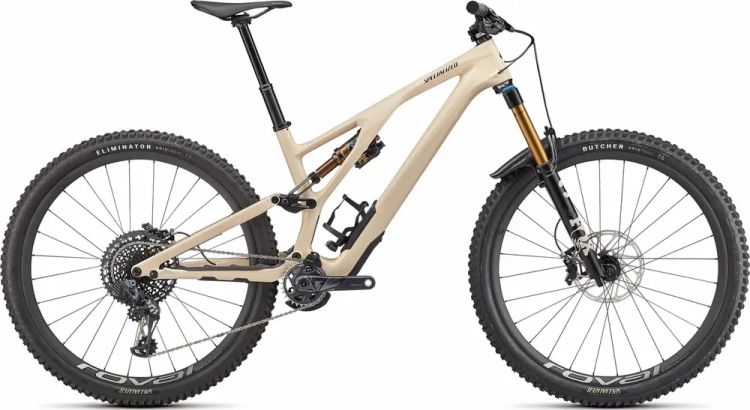
The Santa Cruz NOMAD, which has chosen to be more ingenious in its design, is a big blow to the Specialized Stumpjumper. Compared to the hybrid front and rear tires (29 “x2.4″/2.5″) that handle ascents and descents or terrain changes aggressively, the Stumpjumper wheels (29×2.3”) is a bit more passive. Although I have to admit, it is sharper in terms of wheel acceleration.
In addition, against the 170mm of travel Santa Cruz NOMAD, the Stumpjumper has a slight disadvantage with 150mm in the rear and 160mm in the front although that is also an amazing value. Although I think this is its design to compensate for the different terrain handling, nothing is more effective than a more brutal extension of travel.
On the drivetrain, they both use the more technologically advanced 1×12 electronic drivetrain. Accordingly, in this above the two played a tie.
In terms of material choice, I prefer Santa Cruz’s CC carbon frame. Because it has freer plasticity, a higher sturdiness factor, and is more lightweight.
Pivot Switchblade Team XTR vs Santa Cruz NOMAD X01
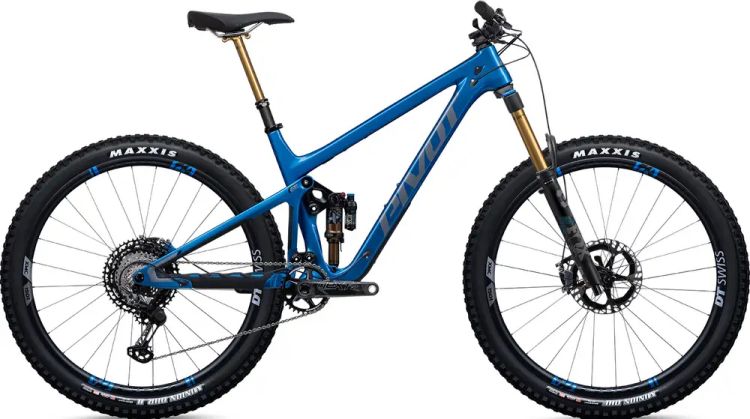
Compared to the Pivot Switchblade Team XTR, which chooses a traditional 1×12 drivetrain, the Santa Cruz NOMAD, which is undoubtedly heavier in technology, is smoother and more responsive, and waterproof. But it has to be said that it will also be more expensive.
In terms of braking, both use more expensive hydraulic disc brakes, so it’s a tie in that regard. And if you notice the more efficient Santa Cruz NOMAD for handling bumps, the Pivot Switchblade Team XTR is a bit more spartan in design. Because the fork travel is 160mm, with 142mm of dw-link™ suspension travel.
Also, unlike the hybrid wheels that come with the Santa Cruz NOMAD, the Pivot Switchblade Team XTR, while supporting more sizes of mounts, still requires you to do your upgrades.
From a rider’s psychological point of view, I think the Santa Cruz NOMAD’s upgrade is a step up. While both are high-end full-suspension enduro bikes, there’s no doubt about that. But I’d be more partial to the Santa Cruz NOMAD.
Learn more : Is Pivot Mach 5.5 Carbon Race X01 Splendid? – [Pivot Mach 5.5 Carbon Race X01 Review]
Yeti SB150 T3 vs Santa Cruz NOMAD X01
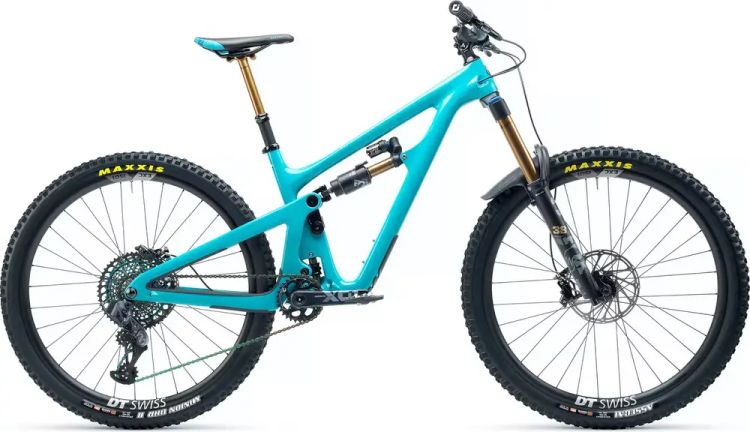
In my comparison of the relatively price-friendly Yeti SB150, I found that it also uses a certain amount of ingenuity in terms of how well the components fit together. Because the TURQ series carbon frame combination the FOX FACTORY 38 suspension fork with 170mm of travel, the expensive SRAM hydraulic disc brakes, and the SRAM XX1 EAGLE drivetrain.
Component fit is very good throughout the bike, but if compared to the industry’s top Santa Cruz, it still lacks a bit of interest. The hybrid front and rear tires (29 “x2.4″/2.5”) handle ascents and descents or terrain changes aggressively, increasing ride compatibility. The more technologically advanced 1×12 electronic drivetrain is smoother and swifter, while the waterproof performance is also tested.
In addition, for the external frame, the 77.9° seat tube angle of the Santa Cruz NOMAD X01 is more friendly for novice riders and will help with endurance riding. The 63.8° head tube angle is more responsive to steering compared to the Yeti SB150. So I think Santa Cruz NOMAD is a step up in detail.
In case, the above comments are helpful to you, please remember to share the subscription. Have a great day!
Learn more : Is Yeti SB150 C1 Splendid ?- [Yeti SB150 C1 Review]

![[Orbea URRUN 10 20mph Review] – Best Used By People Who Enjoy Riding To Get AFeel For The Mountains!](https://bestbikeselect.com/wp-content/uploads/2023/09/2023-Orbea-URRUN-10-20mph-35_-1024x1024.jpg)
![[Specialized Turbo Como 5.0 Review] – Good Choice?](https://bestbikeselect.com/wp-content/uploads/2023/08/2023-Specialized-Turbo-Como-5.01_-1024x1024.webp)
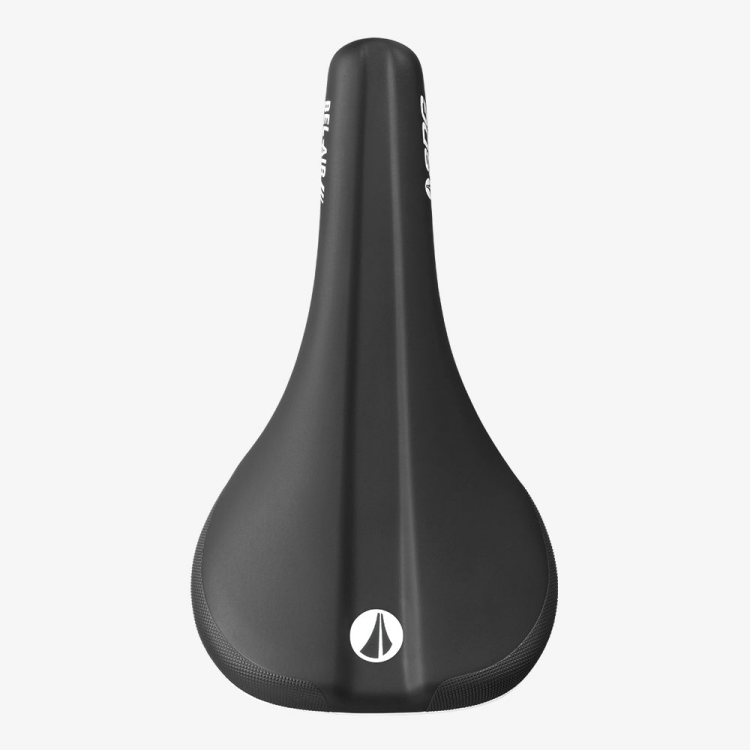
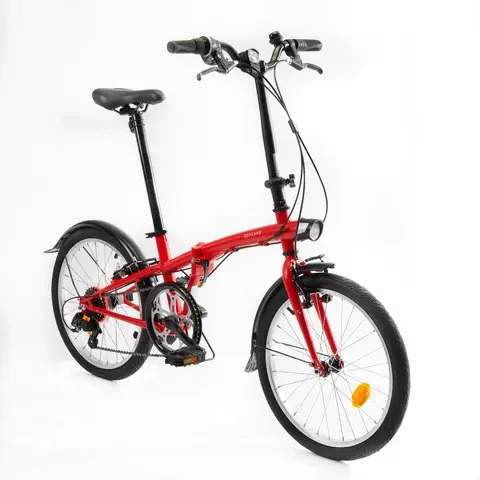

![2025 Built for Champions:[Orbea ORCA M21eTEAM PWR Review]](https://bestbikeselect.com/wp-content/uploads/2025/01/ORCA-M21eTEAM-PWR-1024x885.jpg)
![2025 Conquer Any Trail [Santa Cruz Bronson R Review]](https://bestbikeselect.com/wp-content/uploads/2025/01/Santa-Cruz-Bronson-R-1-1024x768.webp)
![2025 The All-Terrain Beast [Santa Cruz Hightower 3 MY24 Review]](https://bestbikeselect.com/wp-content/uploads/2025/01/Santa-Cruz-Hightower-3-MY24-1024x768.webp)
![The Best Comfortable Leisure Bike of 2025 [ Trek Verve 2 Lowstep Gen 5 ]](https://bestbikeselect.com/wp-content/uploads/2024/12/Verve-2-Lowstep-Gen-5-02-1024x681.png)
![2025’s Top Endurance Bikes [Cannondale Synapse Carbon 3 L Review]](https://bestbikeselect.com/wp-content/uploads/2025/01/Cannondale-Synapse-Carbon-3-L-1-1024x627.webp)